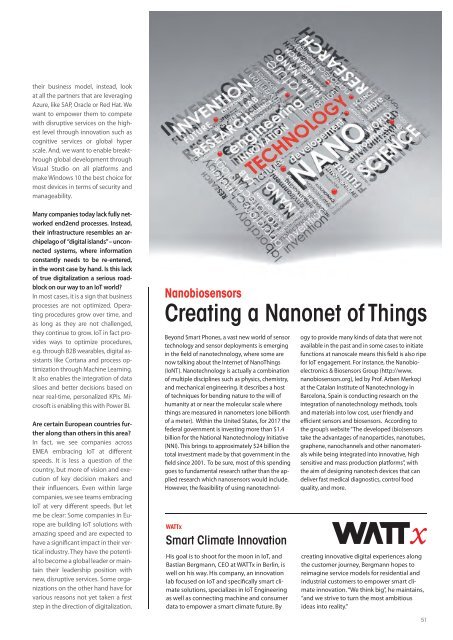Smart Industry 1/2016
Smart Industry 1/2016 - The IoT Business Magazine - powered by Avnet Silica
Smart Industry 1/2016 - The IoT Business Magazine - powered by Avnet Silica
You also want an ePaper? Increase the reach of your titles
YUMPU automatically turns print PDFs into web optimized ePapers that Google loves.
their business model, instead, look<br />
at all the partners that are leveraging<br />
Azure, like SAP, Oracle or Red Hat. We<br />
want to empower them to compete<br />
with disruptive services on the highest<br />
level through innovation such as<br />
cognitive services or global hyper<br />
scale. And, we want to enable breakthrough<br />
global development through<br />
Visual Studio on all platforms and<br />
make Windows 10 the best choice for<br />
most devices in terms of security and<br />
manageability.<br />
Many companies today lack fully networked<br />
end2end processes. Instead,<br />
their infrastructure resembles an archipelago<br />
of “digital islands” – unconnected<br />
systems, where information<br />
constantly needs to be re-entered,<br />
in the worst case by hand. Is this lack<br />
of true digitalization a serious roadblock<br />
on our way to an IoT world?<br />
In most cases, it is a sign that business<br />
processes are not optimized. Operating<br />
procedures grow over time, and<br />
as long as they are not challenged,<br />
they continue to grow. IoT in fact provides<br />
ways to optimize procedures,<br />
e.g. through B2B wearables, digital assistants<br />
like Cortana and process optimization<br />
through Machine Learning.<br />
It also enables the integration of data<br />
siloes and better decisions based on<br />
near real-time, personalized KPIs. Microsoft<br />
is enabling this with Power BI.<br />
Are certain European countries further<br />
along than others in this area?<br />
In fact, we see companies across<br />
EMEA embracing IoT at different<br />
speeds. It is less a question of the<br />
country, but more of vision and execution<br />
of key decision makers and<br />
their influencers. Even within large<br />
companies, we see teams embracing<br />
IoT at very different speeds. But let<br />
me be clear: Some companies in Europe<br />
are building IoT solutions with<br />
amazing speed and are expected to<br />
have a significant impact in their vertical<br />
industry. They have the potential<br />
to become a global leader or maintain<br />
their leadership position with<br />
new, disruptive services. Some organizations<br />
on the other hand have for<br />
various reasons not yet taken a first<br />
step in the direction of digitalization.<br />
Nanobiosensors<br />
Creating a Nanonet of Things<br />
WATTx<br />
<strong>Smart</strong> Climate Innovation<br />
His goal is to shoot for the moon in IoT, and<br />
Bastian Bergmann, CEO at WATTx in Berlin, is<br />
well on his way. His company, an innovation<br />
lab focused on IoT and specifically smart climate<br />
solutions, specializes in IoT Engineering<br />
as well as connecting machine and consumer<br />
data to empower a smart climate future. By<br />
Beyond <strong>Smart</strong> Phones, a vast new world of sensor<br />
technology and sensor deployments is emerging<br />
in the field of nanotechnology, where some are<br />
now talking about the Internet of NanoThings<br />
(IoNT). Nanotechnology is actually a combination<br />
of multiple disciplines such as physics, chemistry,<br />
and mechanical engineering. It describes a host<br />
of techniques for bending nature to the will of<br />
humanity at or near the molecular scale where<br />
things are measured in nanometers (one billionth<br />
of a meter). Within the United States, for 2017 the<br />
federal government is investing more than $1.4<br />
billion for the National Nanotechnology Initiative<br />
(NNI). This brings to approximately $24 billion the<br />
total investment made by that government in the<br />
field since 2001. To be sure, most of this spending<br />
goes to fundamental research rather than the applied<br />
research which nanosensors would include.<br />
However, the feasibility of using nanotechnology<br />
to provide many kinds of data that were not<br />
available in the past and in some cases to initiate<br />
functions at nanoscale means this field is also ripe<br />
for IoT engagement. For instance, the Nanobioelectronics<br />
& Biosensors Group (http://www.<br />
nanobiosensors.org), led by Prof. Arben Merkoçi<br />
at the Catalan Institute of Nanotechnology in<br />
Barcelona, Spain is conducting research on the<br />
integration of nanotechnology methods, tools<br />
and materials into low cost, user friendly and<br />
efficient sensors and biosensors. According to<br />
the group’s website “The developed (bio)sensors<br />
take the advantages of nanoparticles, nanotubes,<br />
graphene, nanochannels and other nanomaterials<br />
while being integrated into innovative, high<br />
sensitive and mass production platforms”, with<br />
the aim of designing nanotech devices that can<br />
deliver fast medical diagnostics, control food<br />
quality, and more.<br />
creating innovative digital experiences along<br />
the customer journey, Bergmann hopes to<br />
reimagine service models for residential and<br />
industrial customers to empower smart climate<br />
innovation. “We think big”, he maintains,<br />
“and we strive to turn the most ambitious<br />
ideas into reality.”<br />
51

















